Recent Development of Carbon-Nanotube-Based Solar Heat Absorption Devices and Their Application
Abstract
1. Introduction
2. CNT-Based Solar Heat Conversion Devices
2.1. Water Purification

2.2. Solar Thermoelectric Generator (STEG)
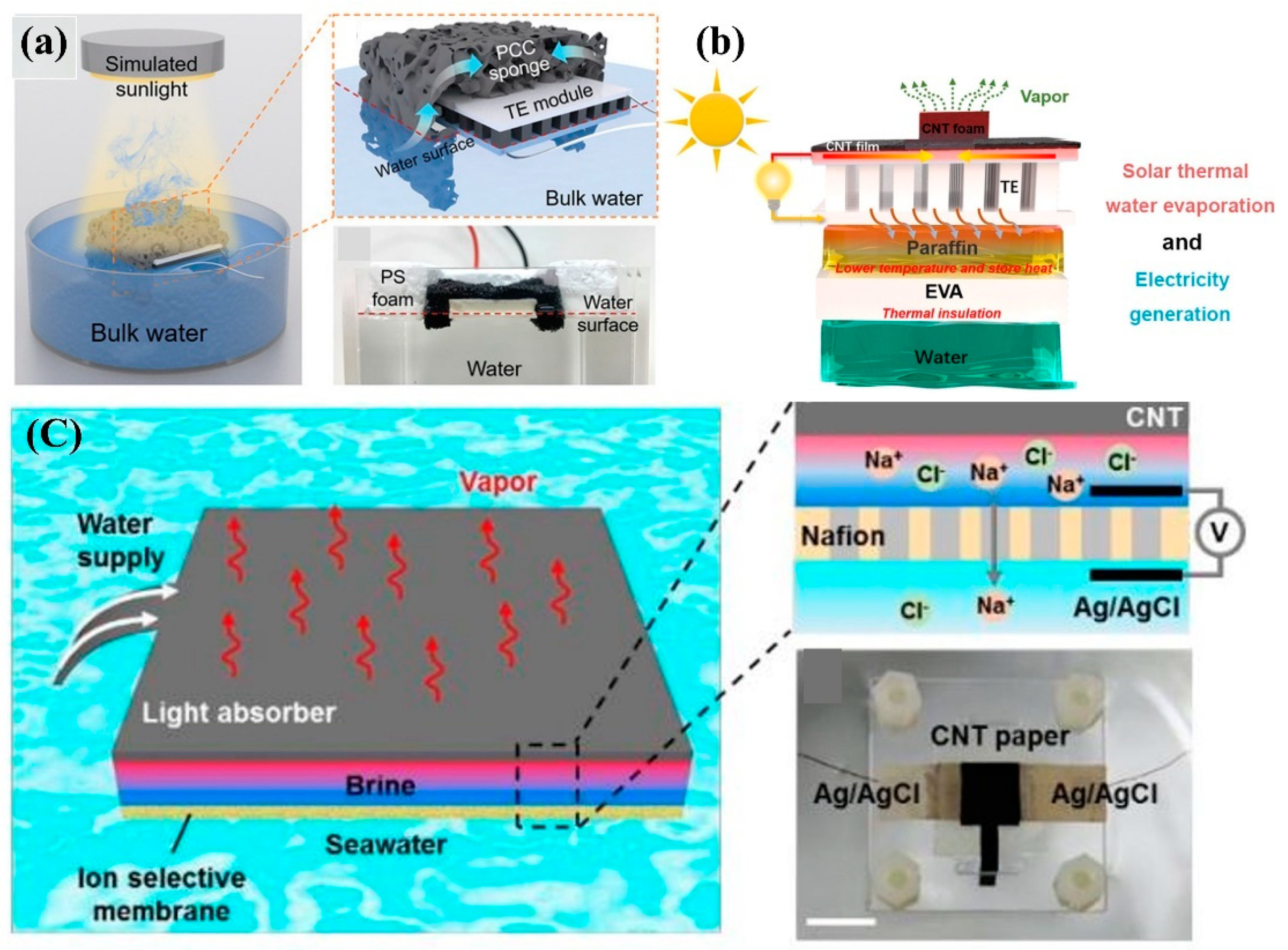
2.3. Solar Water Heater
3. Conclusions
- CNTs are the optimal material for photothermal conversion devices because they are black-body absorbers with high solar light absorption and minimal infrared emissions.
- Applying CNT composites and CNT coatings in solar water purification devices and solar thermoelectric generation devices leads to a remarkable enhancement in the system’s overall efficiency.
- Aerogels composited with CNTs have a soft, porous structure that allows them to function as a secondary filter, eliminating microscopic particles and harmful compounds that generally persist in contaminated water.
- The addition of CNTs to the p/n module of TEGs enhanced the devices’ overall performance by increasing the temperature gradient required to generate electricity.
- CNTs have a high capacity for absorbing heat. The absorber receives diffused solar radiation due to large and small molecules in the environment. CNT-based thermoelectric devices have been shown to produce more power when employing an optical concentrator.
- The thermal storage properties of CNT-based nanofluids increased the collection efficiency of SWH, keeping water hot for an even more prolonged period.
- CNTs with strong hydrophobic properties facilitate the transmission of heat to water without interacting with water molecules.
4. Open Issues to Be Developed
- Due to their nano-size and the difficulty involved in isolating and manipulating them, the practical applications of CNTs for water filtration are restricted. The removal of such microscopic particles from large quantities of water incurs additional costs. Cost-effectively increasing the thermal utilization efficiency of CNT-based photothermal materials remains a substantial obstacle.
- Numerous techniques, including arc discharge, chemical vapor deposition, laser ablation, and flame synthesis, have been devised to produce CNTs. Most of them are time-consuming and involve complex equipment and processes. Another significant problem is that the CNTs synthesized via the proposed techniques are highly hydrophobic, preventing the effective transfer of water to the evaporating surface.
- It is not yet possible to achieve CNT growth across a large space. The poor performance of water purification systems and the absence of technologies for their production are barriers to their use on a large scale.
- Natural solar radiation can be reduced in strength due to the influence of many factors, including weather, climate, and geographical circumstances. Because of the unpredictable nature of solar irradiation, relying solely on testing procedures conducted in the laboratory is a very impractical approach.
- CNT-based SWP devices subjected to intense solar irradiation showed an increase in heat losses due to the significant size of the energy input. It is necessary to perform further research in order to reduce the amount of heat lost due to convection, radiation, and conduction.
- STEG systems still operate with low overall efficiency. Additional research has to be conducted on CNT-based systems encapsulating absorbing materials such CNT coatings and CNT composite materials to improve the overall efficiency of TEGs. These are both implemented on the hot side of the TEG.
- According to the research, only a small number of studies have been performed to investigate how the level of sun intensity affects solar water heating systems. It is recommended that high solar power be implemented over the solar collector in industrial applications in order to generate a higher level of heat energy and produce a large quantity of hot water.
- CNT-based hybrid nanofluids provide a number of benefits over conventional ones. No definitive research has been conducted on the viability of the use of hybrid nanofluids containing CNTs in solar water heating systems. MWCNT nanofluid has attained a high level of effectiveness to date. However, its preparation costs are significantly higher than those of hybrid nanofluids. Consequently, more studies are necessary in order to fabricate hybrid nanofluids based on CNTs.
- It has been shown that CNT-based PCMs for solar water heating systems have relatively few applications, which means that further research must be carried out in the near future.
Supplementary Materials
Author Contributions
Funding
Data Availability Statement
Acknowledgments
Conflicts of Interest
References
- Li, Q.; Zhang, S.; Wei, N.; Xu, R.; Li, X.; Gong, L.; Cui, H. Porous Ni/CNTs composite membrane as solar absorber for highly efficient solar steam generation. Sol. Energy Mater. Sol. Cells 2022, 243, 111815. [Google Scholar] [CrossRef]
- Ahmed, S.F.; Khalid, M.; Vaka, M.; Walvekar, R.; Numan, A.; Rasheed, A.K.; Mubarak, N.M. Recent progress in solar water heaters and solar collectors: A comprehensive review. Therm. Sci. Eng. Prog. 2021, 25, 100981. [Google Scholar] [CrossRef]
- Werber, J.R.; Osuji, C.O.; Elimelech, M. Materials for next-generation desalination and water purification membranes. Nat. Rev. Mater. 2016, 1, 16018. [Google Scholar] [CrossRef]
- Wang, X.; Ou, G.; Wang, N.; Wu, H. Graphene-based Recyclable Photo-Absorbers for High-Efficiency Seawater Desalination. ACS Appl. Mater. Interfaces 2016, 8, 9194–9199. [Google Scholar] [CrossRef] [PubMed]
- Zhang, J.; Wang, C.; Shi, J.; Wei, D.; Zhao, H.; Ma, C. Solar Selective Absorber for Emerging Sustainable Applications. Adv. Energy Sustain. Res. 2022, 3, 2100195. [Google Scholar] [CrossRef]
- Iijima, S. Helical microtubules of graphitic carbon. Nature 1991, 354, 56–58. [Google Scholar] [CrossRef]
- Kataura, H.; Kumazawa, Y.; Maniwa, Y.; Umezu, I.; Suzuki, S.; Ohtsuka, Y.; Achiba, Y. Optical properties of single-wall carbon nanotubes. Synth. Met. 1999, 103, 2555–2558. [Google Scholar] [CrossRef]
- Yang, D.J.; Wang, S.G.; Zhang, Q.; Sellin, P.J.; Chen, G. Thermal and electrical transport in multi-walled carbon nanotubes. Phys. Lett. Sect. A Gen. At. Solid State Phys. 2004, 329, 207–213. [Google Scholar] [CrossRef]
- Salvetat, J.P.; Bonard, J.M.; Thomson, N.H.; Kulik, A.J.; Forro, L.; Benoit, W.; Zuppiroli, L. Mechanical properties of carbon nanotubes. Appl. Phys. A 1999, 69, 255–260. [Google Scholar] [CrossRef]
- Lehman, J.; Yung, C.; Tomlin, N.; Conklin, D.; Stephens, M. Carbon nanotube-based black coatings. Appl. Phys. Rev. 2018, 5, 011103. [Google Scholar] [CrossRef]
- Kouklin, N.; Tzolov, M.; Straus, D.; Yin, A.; Xu, J.M. Infrared absorption properties of carbon nanotubes synthesized by chemical vapor deposition. Appl. Phys. Lett. 2004, 85, 4463–4465. [Google Scholar] [CrossRef]
- Itkis, M.E.; Perea, D.E.; Jung, R.; Niyogi, S.; Haddon, R.C. Comparison of analytical techniques for purity evaluation of single-walled carbon nanotubes. J. Am. Chem. Soc. 2005, 127, 3439–3448. [Google Scholar] [CrossRef] [PubMed]
- Wang, X.J.; Flicker, J.D.; Lee, B.J.; Ready, W.J.; Zhang, Z.M. Visible and near-infrared radiative properties of vertically aligned multi-walled carbon nanotubes. Nanotechnology 2009, 20, 215704. [Google Scholar] [CrossRef] [PubMed]
- Yang, Z.P.; Ci, L.; Bur, J.A.; Lin, S.Y.; Ajayan, P.M. Experimental observation of an extremely dark material made by a low-density nanotube array. Nano Lett. 2008, 8, 446–451. [Google Scholar] [CrossRef]
- Miyaji, H.; Pander, A.; Takano, K.; Kohno, H.; Hatta, A.; Nakajima, M.; Furuta, H. Optical reflectance of patterned frost column-like CNT forest for metamaterial applications. Diam. Relat. Mater. 2018, 83, 196–203. [Google Scholar] [CrossRef]
- Chu, H.; Li, Y.; Wang, C.; Zhang, H.; Li, D. Recent investigations on nonlinear absorption properties of carbon nanotubes. Nanophotonics 2020, 9, 761–781. [Google Scholar] [CrossRef]
- Zhang, Q.; Chen, G.; Yoon, S.F.; Ahn, J.; Wang, S.G.; Zhou, Q.; Wang, Q.; Li, J.Q. Thermal conductivity of multiwalled carbon nanotubes. Phys. Rev. B Condens. Matter Mater. Phys. 2002, 66, 165440. [Google Scholar] [CrossRef]
- Ivanov, I.; Puretzky, A.; Eres, G.; Wang, H.; Pan, Z.; Cui, H.; Jin, R.; Howe, J.; Geohegan, D.B. Fast and highly anisotropic thermal transport through vertically aligned carbon nanotube arrays. Appl. Phys. Lett. 2006, 89, 223110. [Google Scholar] [CrossRef]
- Könemann, F.; Vollmann, M.; Wagner, T.; Mohd Ghazali, N.; Yamaguchi, T.; Stemmer, A.; Ishibashi, K.; Gotsmann, B. Thermal Conductivity of a Supported Multiwalled Carbon Nanotube. J. Phys. Chem. C 2019, 123, 12460–12465. [Google Scholar] [CrossRef]
- Pop, E.; Mann, D.; Wang, Q.; Goodson, K.; Dai, H. Thermal conductance of an individual single-wall carbon nanotube above room temperature. Nano Lett. 2006, 6, 96–100. [Google Scholar] [CrossRef]
- Fujii, M.; Zhang, X.; Xie, H.; Ago, H.; Takahashi, K.; Ikuta, T.; Abe, H.; Shimizu, T. Measuring the thermal conductivity of a single carbon nanotube. Phys. Rev. Lett. 2005, 95, 065502. [Google Scholar] [CrossRef] [PubMed]
- Hone, J.; Llaguno, M.C.; Biercuk, M.J.; Johnson, A.T.; Batlogg, B.; Benes, Z.; Fischer, J.E. Thermal properties of carbon nanotubes and nanotube-based materials. Appl. Phys. A Mater. Sci. Process 2002, 74, 339–343. [Google Scholar] [CrossRef]
- Mu, J.; Hou, C.; Wang, H.; Li, Y.; Zhang, Q. Graphene-carbon nanotube papers for energy conversion and storage under sunlight and heat. Carbon 2015, 95, 150–156. [Google Scholar] [CrossRef]
- Jamil, M.M.; Che Sidik, N.A.; Umar, U.S.; Hamisu, M.T.; Sa’ad, A. Carbon Nanotube for Solar Energy Applications: A Review. J. Adv. Res. Fluid Mech. Therm. Sci. 2019, 56, 233–247. Available online: www.akademiabaru.com/arfmts.html (accessed on 13 April 2019).
- Cui, L.; Zhang, Y.; Du, X.; Wei, G. Computational study on thermal conductivity of defective carbon nanomaterials: Carbon nanotubes versus graphene nanoribbons. J. Mater. Sci. 2018, 53, 4242–4251. [Google Scholar] [CrossRef]
- Caccamo, M.T.; Mavilia, G.; Magazù, S. Thermal investigations on carbon nanotubes by spectroscopic techniques. Appl. Sci. 2020, 10, 8159. [Google Scholar] [CrossRef]
- Hone, J.; Llaguno, M.C.; Nemes, N.M.; Johnson, A.T. Electrical and thermal transport properties of magnetically aligned single wall carbon nanotube films. Appl. Phys. Lett. 2000, 77, 666–668. [Google Scholar] [CrossRef]
- Zhan, H.; Chen, Y.W.; Shi, Q.Q.; Zhang, Y.; Mo, R.W.; Wang, J.N. Highly aligned and densified carbon nanotube films with superior thermal conductivity and mechanical strength. Carbon 2022, 186, 205–214. [Google Scholar] [CrossRef]
- Wang, X.; Zhong, Z.; Xu, J. Noncontact thermal characterization of multiwall carbon nanotubes. J. Appl. Phys. 2005, 97, 064302. [Google Scholar] [CrossRef]
- Zhang, L.; Zhang, G.; Liu, C.; Fan, S. High-density carbon nanotube buckypapers with superior transport and mechanical properties. Nano Lett. 2012, 12, 4848–4852. [Google Scholar] [CrossRef]
- Yang, X.; Cui, J.; Xue, K.; Fu, Y.; Li, H.; Yang, H. Thermal conductivity and thermoelectric properties in 3D macroscopic pure carbon nanotube materials. Nanotechnol. Rev. 2021, 10, 178–186. [Google Scholar] [CrossRef]
- Ryu, S.; Nguyen, D.C.; Ha, N.Y.; Park, H.J.; Ahn, Y.H.; Park, J.Y.; Lee, S. Light Intensity-dependent Variation in Defect Contributions to Charge Transport and Recombination in a Planar MAPbI3 Perovskite Solar Cell. Sci. Rep. 2019, 9, 19846. [Google Scholar] [CrossRef] [PubMed]
- Qiu, Y.; Lee, M.; Chen, J.; Zhang, Q. Effect of light intensity on solar-driven interfacial steam generation. Nanoscale 2021, 13, 20387–20395. [Google Scholar] [CrossRef]
- Herrera, V. Reconciling global aspirations and local realities: Challenges facing the Sustainable Development Goals for water and sanitation. World Dev. 2019, 118, 106–117. [Google Scholar] [CrossRef]
- Kumar, N.M.; Chopra, S.S.; Chand, A.A.; Elavarasan, R.M.; Shafiullah, G.M. Hybrid renewable energy microgrid for a residential community: A techno-economic and environmental perspective in the context of the SDG7. Sustainability 2020, 12, 3944. [Google Scholar] [CrossRef]
- Wu, B.; Guo, Y.; Hou, C.; Zhang, Q.; Li, Y.; Wang, H. From carbon nanotubes to highly adaptive and flexible high-performance thermoelectric generators. Nano Energy 2021, 89, 106487. [Google Scholar] [CrossRef]
- Qin, D.D.; Zhu, Y.J.; Chen, F.F.; Yang, R.L.; Xiong, Z.C. Self-floating aerogel composed of carbon nanotubes and ultralong hydroxyapatite nanowires for highly efficient solar energy-assisted water purification. Carbon 2019, 150, 233–243. [Google Scholar] [CrossRef]
- Kou, H.; Liu, Z.; Zhu, B.; Macharia, D.K.; Ahmed, S.; Wu, B.; Zhu, M.; Liu, X.; Chen, Z. Recyclable CNT-coupled cotton fabrics for low-cost and efficient desalination of seawater under sunlight. Desalination 2019, 462, 29–38. [Google Scholar] [CrossRef]
- Zhang, Y.; Xiong, T.; Nandakumar, D.K.; Tan, S.C. Structure Architecting for Salt-Rejecting Solar Interfacial Desalination to Achieve High-Performance Evaporation with in Situ Energy Generation. Adv. Sci. 2020, 7, 1903478. [Google Scholar] [CrossRef]
- Mu, X.; Gu, Y.; Wang, P.; Shi, J.; Wei, A.; Tian, Y.; Zhou, J.; Chen, Y.; Zhang, J.; Sun, Z.; et al. Energy Matching for Boosting Water Evaporation in Direct Solar Steam Generation. Solar RRL 2020, 4, 2000341. [Google Scholar] [CrossRef]
- He, M.; Liu, H.; Wang, L.; Qin, X.; Yu, J. One-step fabrication of a stretchable and anti-oil-fouling nanofiber membrane for solar steam generation. Mater. Chem. Front. 2021, 5, 3673–3680. [Google Scholar] [CrossRef]
- Zhu, B.; Kou, H.; Liu, Z.; Wang, Z.; Macharia, D.K.; Zhu, M.; Wu, B.; Liu, X.; Chen, Z. Flexible and Washable CNT-Embedded PAN Nonwoven Fabrics for Solar-Enabled Evaporation and Desalination of Seawater. ACS Appl. Mater. Interfaces 2019, 11, 35005–35014. [Google Scholar] [CrossRef] [PubMed]
- Han, S.; Yang, J.; Li, X.; Li, W.; Zhang, X.; Koratkar, N.; Yu, Z.Z. Flame Synthesis of Superhydrophilic Carbon Nanotubes/Ni Foam Decorated with Fe2O3 Nanoparticles for Water Purification via Solar Steam Generation. ACS Appl. Mater. Interfaces 2020, 12, 13229–13238. [Google Scholar] [CrossRef] [PubMed]
- Jiang, F.; Liu, H.; Li, Y.; Kuang, Y.; Xu, X.; Chen, C.; Huang, H.; Jia, C.; Zhao, X.; Hitz, E.; et al. Lightweight, Mesoporous, and Highly Absorptive All-Nanofiber Aerogel for Efficient Solar Steam Generation. ACS Appl. Mater. Interfaces 2018, 10, 1104–1112. [Google Scholar] [CrossRef] [PubMed]
- Miao, E.D.; Ye, M.Q.; Guo, C.L.; Liang, L.; Liu, Q.; Rao, Z.H. Enhanced solar steam generation using carbon nanotube membrane distillation device with heat localization. Appl. Therm. Eng. 2019, 149, 1255–1264. [Google Scholar] [CrossRef]
- Zhang, S.; Ma, H.; Guo, D.; Guo, P.; Wang, J.; Liu, M.; Wu, S.; Bao, C. Multiscale Preparation of Graphene Oxide/Carbon Nanotube-Based Membrane Evaporators by a Spray Method for Efficient Solar Steam Generation. ACS Appl. Nano Mater. 2022, 5, 7198–7207. [Google Scholar] [CrossRef]
- Wang, X.; He, Y.; Liu, X.; Zhu, J. Enhanced direct steam generation via a bio-inspired solar heating method using carbon nanotube films. Powder Technol. 2017, 321, 276–285. [Google Scholar] [CrossRef]
- Wang, Y.; Liu, H.; Chen, C.; Kuang, Y.; Song, J.; Xie, H.; Jia, C.; Kronthal, S.; Xu, X.; He, S.; et al. All Natural, High Efficient Groundwater Extraction via Solar Steam/Vapor Generation. Adv. Sustain. Syst. 2019, 3, 1800055. [Google Scholar] [CrossRef]
- Yin, Z.; Wang, H.; Jian, M.; Li, Y.; Xia, K.; Zhang, M.; Wang, C.; Wang, Q.; Ma, M.; Zheng, Q.; et al. Extremely Black Vertically Aligned Carbon Nanotube Arrays for Solar Steam Generation. ACS Appl. Mater. Interfaces 2017, 9, 28596–28603. [Google Scholar] [CrossRef]
- Zhou, W.; Zhou, C.; Deng, C.; Chen, L.; Zeng, X.; Zhang, Y.; Tan, L.; Hu, B.; Guo, S.; Dong, L.; et al. High-Performance Freshwater Harvesting System by Coupling Solar Desalination and Fog Collection with Hierarchical Porous Microneedle Arrays. Adv. Funct. Mater. 2022, 32, 2113264. [Google Scholar] [CrossRef]
- Mu, P.; Zhang, Z.; Bai, W.; He, J.; Sun, H.; Zhu, Z.; Liang, W.; Li, A. Superwetting Monolithic Hollow-Carbon-Nanotubes Aerogels with Hierarchically Nanoporous Structure for Efficient Solar Steam Generation. Adv. Energy Mater. 2019, 9, 1802158. [Google Scholar] [CrossRef]
- Li, W.; Feng, W.; Wu, S.; Wang, W.; Yu, D. Synergy of photothermal effect in integrated 0D Ti2O3 nanoparticles/1D carboxylated carbon nanotubes for multifunctional water purification. Sep. Purif. Technol. 2022, 292, 120989. [Google Scholar] [CrossRef]
- Xu, X.; Wan, X.; Li, H.; Zhang, Y.; He, W.; Wang, S.; Wang, M.; Hou, X.; Wang, S. Oil-polluted water purification via the carbon-nanotubes-doped organohydrogel platform. Nano Res. 2022, 15, 5653–5662. [Google Scholar] [CrossRef]
- Li, G.; Wang, Q.; Wang, J.; Ye, J.; Zhou, W.; Xu, J.; Zhuo, S.; Chen, W.; Liu, Y. Carbon-supported nano tungsten bronze aerogels with synergistically enhanced photothermal conversion performance: Fabrication and application in solar evaporation. Carbon 2022, 195, 263–271. [Google Scholar] [CrossRef]
- Yang, Z.; Zang, L.; Dou, T.; Xin, Y.; Zhang, Y.; Zhao, D.; Sun, L. Asymmetric Cellulose/Carbon Nanotubes Membrane with Interconnected Pores Fabricated by Droplet Method for Solar-Driven Interfacial Evaporation and Desalination. Membranes 2022, 12, 369. [Google Scholar] [CrossRef] [PubMed]
- Yang, Y.; Liu, C.; Zhao, M.; Wang, J.; Tian, X. Highly Efficient Solar Steam Generation under Low Solar Flux via Carbon-Nanotube-Modified Sugarcane. Energy Technol. 2021, 9, 2100588. [Google Scholar] [CrossRef]
- Cao, P.; Zhao, L.; Zhang, J.; Zhang, L.; Yuan, P.; Zhang, Y.; Li, Q. Gradient Heating Effect Modulated by Hydrophobic/Hydrophilic Carbon Nanotube Network Structures for Ultrafast Solar Steam Generation. ACS Appl. Mater. Interfaces 2021, 13, 19109–19116. [Google Scholar] [CrossRef] [PubMed]
- Wang, Y.; Qi, Q.; Fan, J.; Wang, W.; Yu, D. Simple and robust MXene/carbon nanotubes/cotton fabrics for textile wastewater purification via solar-driven interfacial water evaporation. Sep. Purif. Technol. 2021, 254, 117615. [Google Scholar] [CrossRef]
- Hong, S.; Shi, Y.; Li, R.; Zhang, C.; Jin, Y.; Wang, P. Nature-Inspired, 3D Origami Solar Steam Generator toward Near Full Utilization of Solar Energy. ACS Appl. Mater. Interfaces 2018, 10, 28517–28524. [Google Scholar] [CrossRef]
- Wu, L.; Dong, Z.; Cai, Z.; Ganapathy, T.; Fang, N.X.; Li, C.; Yu, C.; Zhang, Y.; Song, Y. Highly efficient three-dimensional solar evaporator for high salinity desalination by localized crystallization. Nat. Commun. 2020, 11, 521. [Google Scholar] [CrossRef]
- Jin, M.; Wu, Z.; Guan, F.; Zhang, D.; Wang, B.; Sheng, N.; Qu, X.; Deng, L.; Chen, S.; Chen, Y.; et al. Hierarchically Designed Three-Dimensional Composite Structure on a Cellulose-Based Solar Steam Generator. ACS Appl. Mater. Interfaces 2022, 14, 12284–12294. [Google Scholar] [CrossRef] [PubMed]
- Gan, Q.; Zhang, T.; Chen, R.; Wang, X.; Ye, M. Simple, Low-Dose, Durable, and Carbon-Nanotube-Based Floating Solar Still for Efficient Desalination and Purification. ACS Sustain. Chem. Eng. 2019, 7, 3925–3932. [Google Scholar] [CrossRef]
- Li, L.; Zang, L.; Zhang, S.; Dou, T.; Han, X.; Zhao, D.; Zhang, Y.; Sun, L.; Zhang, Y. GO/CNT-silica Janus nanofibrous membrane for solar-driven interfacial steam generation and desalination. J. Taiwan Inst. Chem. Eng. 2020, 111, 191–197. [Google Scholar] [CrossRef]
- Yang, X.; Yang, Y.; Fu, L.; Zou, M.; Li, Z.; Cao, A.; Yuan, Q. An Ultrathin Flexible 2D Membrane Based on Single-Walled Nanotube–MoS2 Hybrid Film for High-Performance Solar Steam Generation. Adv. Funct. Mater. 2018, 28, 1704505. [Google Scholar] [CrossRef]
- Shi, L.; He, Y.; Huang, Y.; Jiang, B. Recyclable Fe3O4@CNT nanoparticles for high-efficiency solar vapor generation. Energy Convers. Manag. 2017, 149, 401–408. [Google Scholar] [CrossRef]
- Chen, C.; Li, Y.; Song, J.; Yang, Z.; Kuang, Y.; Hitz, E.; Jia, C.; Gong, A.; Jiang, F.; Zhu, J.Y. Highly Flexible and Efficient Solar Steam Generation Device. Adv. Mater. 2017, 29, 1701756. [Google Scholar] [CrossRef] [PubMed]
- Li, W.; Li, X.; Liu, J.; Zeng, M.J.; Feng, X.; Jia, X.; Yu, Z.Z. Coating of Wood with Fe2O3-Decorated Carbon Nanotubes by One-Step Combustion for Efficient Solar Steam Generation. ACS Appl. Mater. Interfaces 2021, 13, 22845–22854. [Google Scholar] [CrossRef]
- Liu, C.J. Energy-efficient routes of fabricating thermoelectric materials. In Handbook of Greener Synthesis of Nanomaterials and Compounds: Volume 2: Synthesis at the Macroscale and Nanoscale; Elsevier: Amsterdam, The Netherlands, 2021; pp. 521–548. [Google Scholar] [CrossRef]
- Putri, Y.E.; Said, S.M.; Diantoro, M. Nanoarchitectured titanium complexes for thermal mitigation in thermoelectric materials. Renew. Sustain. Energy Rev. 2019, 101, 346–360. [Google Scholar] [CrossRef]
- Hung, N.T.; Nugraha, A.R.T.; Saito, R. Thermoelectric properties of carbon nanotubes. Energies 2019, 12, 4561. [Google Scholar] [CrossRef]
- Li, K.; Xu, L.; Li, Z.; Wang, Y.; Wang, J.; Qi, X.; Li, Q.; Wang, H. Enhanced thermoelectric performance and tunable polarity in 2D Cu2S-phenol superlattices composites for solar energy conversion. Nano Energy 2021, 84, 105902. [Google Scholar] [CrossRef]
- Cao, P.; Zhao, L.; Yang, Z.; Yuan, P.; Zhang, Y.; Li, Q. Carbon Nanotube Network-Based Solar-Thermal Water Evaporator and Thermoelectric Module for Electricity Generation. ACS Appl. Nano Mater. 2021, 4, 8906–8912. [Google Scholar] [CrossRef]
- Zhu, L.; Ding, T.; Gao, M.; Peh, C.K.N.; Ho, G.W. Shape Conformal and Thermal Insulative Organic Solar Absorber Sponge for Photothermal Water Evaporation and Thermoelectric Power Generation. Adv. Energy Mater. 2019, 9, 1900250. [Google Scholar] [CrossRef]
- Duan, Y.; Weng, M.; Zhang, W.; Qian, Y.; Luo, Z.; Chen, L. Multi-functional carbon nanotube paper for solar water evaporation combined with electricity generation and storage. Energy Convers. Manag. 2021, 241, 114306. [Google Scholar] [CrossRef]
- Chiba, T.; Amma, Y.; Takashiri, M. Heat source free water floating carbon nanotube thermoelectric generators. Sci. Rep. 2021, 11, 14707. [Google Scholar] [CrossRef] [PubMed]
- Jurado, J.P.; Dörling, B.; Zapata-Arteaga, O.; Roig, A.; Mihi, A.; Campoy-Quiles, M. Solar Harvesting: A Unique Opportunity for Organic Thermoelectrics? Adv. Energy Mater. 2019, 9, 1902385. [Google Scholar] [CrossRef]
- Li, K.; Sun, X.; Wang, Y.; Wang, J.; Dai, X.; Li, G.; Wang, H. All-in-one single-piece flexible solar thermoelectric generator with scissored heat rectifying p-n modules. Nano Energy 2022, 93, 106789. [Google Scholar] [CrossRef]
- Li, L.; Gao, X.; Zhang, G.; Xie, W.; Wang, F.; Yao, W. Combined solar concentration and carbon nanotube absorber for high performance solar thermoelectric generators. Energy Convers. Manag. 2019, 183, 109–115. [Google Scholar] [CrossRef]
- Liu, X.; Su, H.; Huang, Z.; Lin, P.; Yin, T.; Sheng, X.; Chen, Y. Biomass-based phase change material gels demonstrating solar-thermal conversion and thermal energy storage for thermoelectric power generation and personal thermal management. Sol. Energy 2022, 239, 307–318. [Google Scholar] [CrossRef]
- Zhang, Y.; Fan, Z.; Wen, N.; Yang, S.; Li, C.; Huang, H.; Cong, T.; Zhang, H.; Pan, L. Novel Wearable Pyrothermoelectric Hybrid Generator for Solar Energy Harvesting. ACS Appl. Mater. Interfaces 2022, 14, 17330–17339. [Google Scholar] [CrossRef]
- Xia, D.; Jiang, S.; Liu, C.; Fan, S.; Chen, L. A demo solar thermoelectric conversion device based on Bi2Te3 and carbon nanotubes. Sol. Energy Mater. Sol. Cells 2015, 141, 331–336. [Google Scholar] [CrossRef]
- Zhang, Y.; Lu, R.; Zhang, S.; Tang, B. Intelligent light-driven flexible solar thermoelectric system. Chem. Eng. J. 2021, 423, 130260. [Google Scholar] [CrossRef]
- Xue, G.; Xu, Y.; Ding, T.; Li, J.; Yin, J.; Fei, W.; Cao, Y.; Yu, J.; Yuan, L.; Gong, L.; et al. Water-evaporation-induced electricity with nanostructured carbon materials. Nat. Nanotechnol. 2017, 12, 317–321. [Google Scholar] [CrossRef] [PubMed]
- Ding, Y.; Li, S.; Tian, J.; Wang, F.; Shi, Y.; Tao, X.; Wang, X.; Lei, R.; Chen, X. CNTs/Wood Composite Nanogenerator for Producing Both Steam and Electricity. ACS Appl. Electron. Mater. 2021, 3, 5287–5295. [Google Scholar] [CrossRef]
- Xiao, P.; He, J.; Ni, F.; Zhang, C.; Liang, Y.; Zhou, W.; Gu, J.; Xia, J.; Kuo, S.-W.; Chen, T. Exploring interface confined water flow and evaporation enables solar-thermal-electro integration towards clean water and electricity harvest via asymmetric functionalization strategy. Nano Energy 2020, 68, 104385. [Google Scholar] [CrossRef]
- Yang, P.; Liu, K.; Chen, Q.; Li, J.; Duan, J.; Xue, G.; Xu, Z.; Xie, W.; Zhou, J. Solar-driven simultaneous steam production and electricity generation from salinity. Energy Environ. Sci. 2017, 10, 1923–1927. [Google Scholar] [CrossRef]
- Wang, Z.; Wang, L.; Elimelech, M. Viability of Harvesting Salinity Gradient (Blue) Energy by Nanopore-Based Osmotic Power Generation. Engineering 2022, 9, 51–60. [Google Scholar] [CrossRef]
- Ajeena, A.M.; Víg, P.; Farkas, I. A comprehensive analysis of nanofluids and their practical applications for flat plate solar collectors: Fundamentals, thermophysical properties, stability, and difficulties. Energy Rep. 2022, 8, 4461–4490. [Google Scholar] [CrossRef]
- Eltaweel, M.; Abdel-Rehim, A.A.; Attia, A.A.A. A comparison between flat-plate and evacuated tube solar collectors in terms of energy and exergy analysis by using nanofluid. Appl. Therm. Eng. 2021, 186, 116516. [Google Scholar] [CrossRef]
- Bernard, S.S.; Suresh, G.; Ahmed, M.D.J.; Mageshwaran, G.; Madanagopal, V.; Karthikeyan, J. Performance analysis of MWCNT fluid parabolic trough collector for whole year. Mater. Today Proc. 2021, 45, 1308–1311. [Google Scholar] [CrossRef]
- Farhana, K.; Kadirgama, K.; Rahman, M.M.; Ramasamy, D.; Noor, M.M.; Najafi, G.; Samykano, M.; Mahamude, A.S.F. Improvement in the performance of solar collectors with nanofluids—A state-of-the-art review. Nano-Struct. Nano-Objects 2019, 18, 100276. [Google Scholar] [CrossRef]
- Saleh, B.; Sundar, L.S. Thermal efficiency, heat transfer, and friction factor analyses of mwcnt + Fe3O4/water hybrid nanofluids in a solar flat plate collector under thermosyphon condition. Processes 2021, 9, 180. [Google Scholar] [CrossRef]
- Pugsley, A.; Zacharopoulos, A.; Smyth, M.; Mondol, J. Performance evaluation of the senergy polycarbonate and asphalt carbon nanotube solar water heating collectors for building integration. Renew. Energy 2019, 137, 2–9. [Google Scholar] [CrossRef]
- Verma, S.K.; Tiwari, A.K.; Tiwari, S.; Chauhan, D.S. Performance analysis of hybrid nanofluids in flat plate solar collector as an advanced working fluid. Sol. Energy 2018, 167, 231–241. [Google Scholar] [CrossRef]
- Struchalin, P.G.; Kuzmenkov, D.M.; Yunin, V.S.; Wang, X.; He, Y.; Balakin, B.V. Hybrid Nanofluid in a Direct Absorption Solar Collector: Magnetite vs. Carbon Nanotubes Compete for Thermal Performance. Energies 2022, 15, 1604. [Google Scholar] [CrossRef]
- Chen, G.; Su, Y.; Jiang, D.; Pan, L.; Li, S. An experimental and numerical investigation on a paraffin wax/graphene oxide/carbon nanotubes composite material for solar thermal storage applications. Appl. Energy 2020, 264, 114786. [Google Scholar] [CrossRef]
- Hussein, O.A.; Habib, K.; Muhsan, A.S.; Saidur, R.; Alawi, O.A.; Ibrahim, T.K. Thermal performance enhancement of a flat plate solar collector using hybrid nanofluid. Sol. Energy 2020, 204, 208–222. [Google Scholar] [CrossRef]
- Tong, Y.; Chi, X.; Kang, W.; Cho, H. Comparative investigation of efficiency sensitivity in a flat plate solar collector according to nanofluids. Appl. Therm. Eng. 2020, 174, 115346. [Google Scholar] [CrossRef]
- Colangelo, G.; Favale, E.; Miglietta, P.; de Risi, A. Innovation in flat solar thermal collectors: A review of the last ten years experimental results. Renew. Sustain. Energy Rev. 2016, 57, 1141–1159. [Google Scholar] [CrossRef]
- Natarajan, E.; Sathish, R. Role of nanofluids in solar water heater. Int. J. Adv. Manuf. Technol. 2009, 1–5. [Google Scholar] [CrossRef]
- Mesgari, S.; Taylor, R.A.; Hjerrild, N.E.; Crisostomo, F.; Li, Q.; Scott, J. An investigation of thermal stability of carbon nanofluids for solar thermal applications. Sol. Energy Mater. Sol. Cells 2016, 157, 652–659. [Google Scholar] [CrossRef]
- Peng, H.; Guo, W.; Li, M. Thermal-hydraulic and thermodynamic performances of liquid metal based nanofluid in parabolic trough solar receiver tube. Energy 2020, 192, 116564. [Google Scholar] [CrossRef]
- Ghodbane, M.; Said, Z.; Hachicha, A.A.; Boumeddane, B. Performance assessment of linear Fresnel solar reflector using MWCNTs/DW nanofluids. Renew. Energy 2020, 151, 43–56. [Google Scholar] [CrossRef]
- In Kim, S.; Kissick, J.; Spence, S.; Boyle, C. Design, analysis and performance of a polymer-carbon nanotubes based economic solar collector. Sol. Energy 2016, 134, 251–263. [Google Scholar] [CrossRef]
- Mahbubul, I.M.; Khan, M.M.A.; Ibrahim, N.I.; Ali, H.M.; Al-Sulaiman, F.A.; Saidur, R. Carbon nanotube nanofluid in enhancing the efficiency of evacuated tube solar collector. Renew. Energy 2018, 121, 36–44. [Google Scholar] [CrossRef]
- Eltaweel, M.; Abdel-Rehim, A.A. Energy and exergy analysis of a thermosiphon and forced-circulation flat-plate solar collector using MWCNT/Water nanofluid. Case Stud. Therm. Eng. 2019, 14, 100416. [Google Scholar] [CrossRef]
- Verma, S.K.; Tiwari, A.K.; Chauhan, D.S. Experimental evaluation of flat plate solar collector using nanofluids. Energy Convers. Manag. 2017, 134, 103–115. [Google Scholar] [CrossRef]
- Kalidoss, P.; Venkatachalapathy, S.G.; Suresh, S. Photothermal performance of hybrid nanofluids with different base fluids for solar energy applications. Energy Sources Part A Recovery Util. Environ. Eff. 2021, 1–6. [Google Scholar] [CrossRef]
- Li, X.; Zeng, G.; Lei, X. The stability, optical properties and solar-thermal conversion performance of SiC-MWCNTs hybrid nanofluids for the direct absorption solar collector (DASC) application. Sol. Energy Mater. Sol. Cells 2020, 206, 110323. [Google Scholar] [CrossRef]
- Alzahrani, A.K.; Ullah, M.Z.; Alshomrani, A.S.; Gul, T. Hybrid nanofluid flow in a Darcy-Forchheimer permeable medium over a flat plate due to solar radiation. Case Stud. Therm. Eng. 2021, 26, 100955. [Google Scholar] [CrossRef]
- Henein, S.M.; Abdel-Rehim, A.A. The performance response of a heat pipe evacuated tube solar collector using MgO/MWCNT hybrid nanofluid as a working fluid. Case Stud. Therm. Eng. 2022, 33, 101957. [Google Scholar] [CrossRef]
- Mashhadian, A.; Heyhat, M.M.; Mahian, O. Improving environmental performance of a direct absorption parabolic trough collector by using hybrid nanofluids. Energy Convers. Manag. 2021, 244, 114450. [Google Scholar] [CrossRef]
- Shao, F.; Xi, S.; Wang, L.; Xie, H.; Yu, W. Popcorn-derived porous carbon based adipic acid composite phase change materials for direct solar energy storage systems. J. Energy Storage 2022, 52, 104972. [Google Scholar] [CrossRef]
- Weaver, R.; Lim, C.S.L.; Sobhansarbandi, S. Thermal performance improvement of energy storage materials for low operating temperature solar water heating systems. Sustain. Energy Technol. Assess. 2022, 52, 102298. [Google Scholar] [CrossRef]
- Sobhansarbandi, S.; Martinez, P.M.; Papadimitratos, A.; Zakhidov, A.; Hassanipour, F. Evacuated tube solar collector with multifunctional absorber layers. Sol. Energy 2017, 146, 342–350. [Google Scholar] [CrossRef]
- Chamkha, A.J.; Rufuss, D.; Kabeel, A.E.; Sathyamurthy, R.; Abdelgaid, M.; Manokar, A.M.; Madhu, B. Augmenting the potable water produced from single slope solar still using CNT-doped paraffin wax as energy storage: An experimental approach. J. Braz. Soc. Mech. Sci. Eng. 2020, 42, 625. [Google Scholar] [CrossRef]
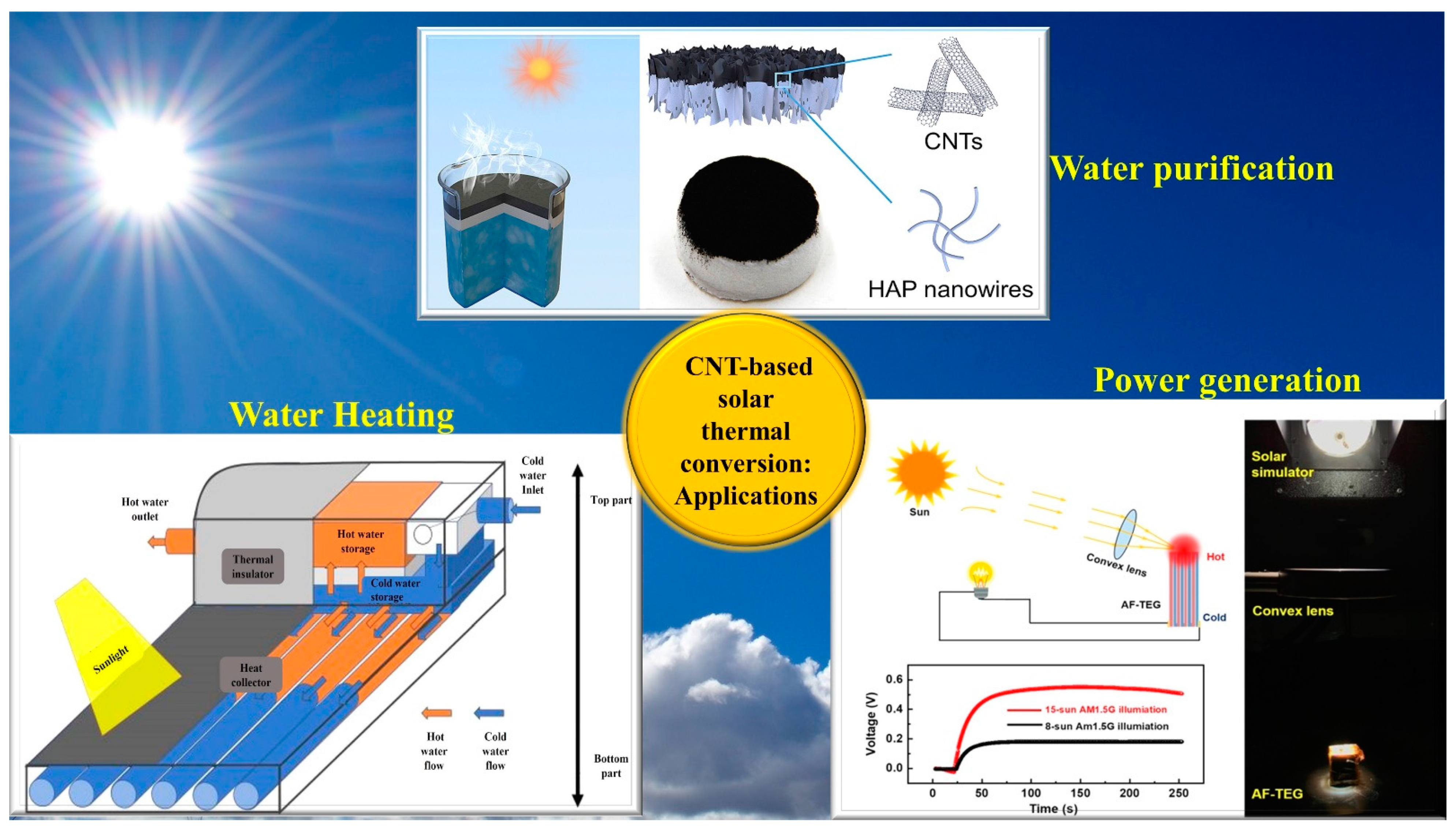
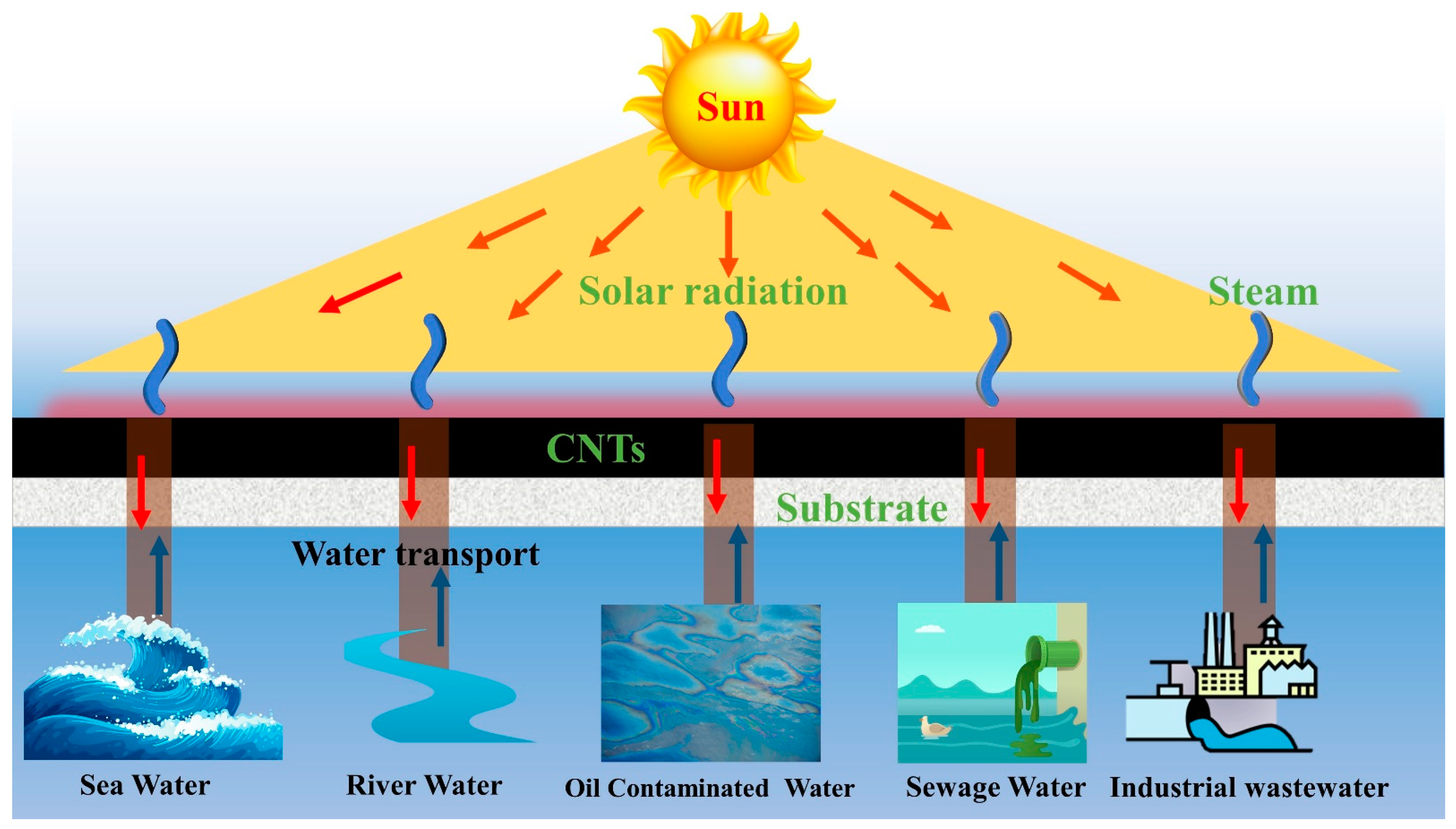
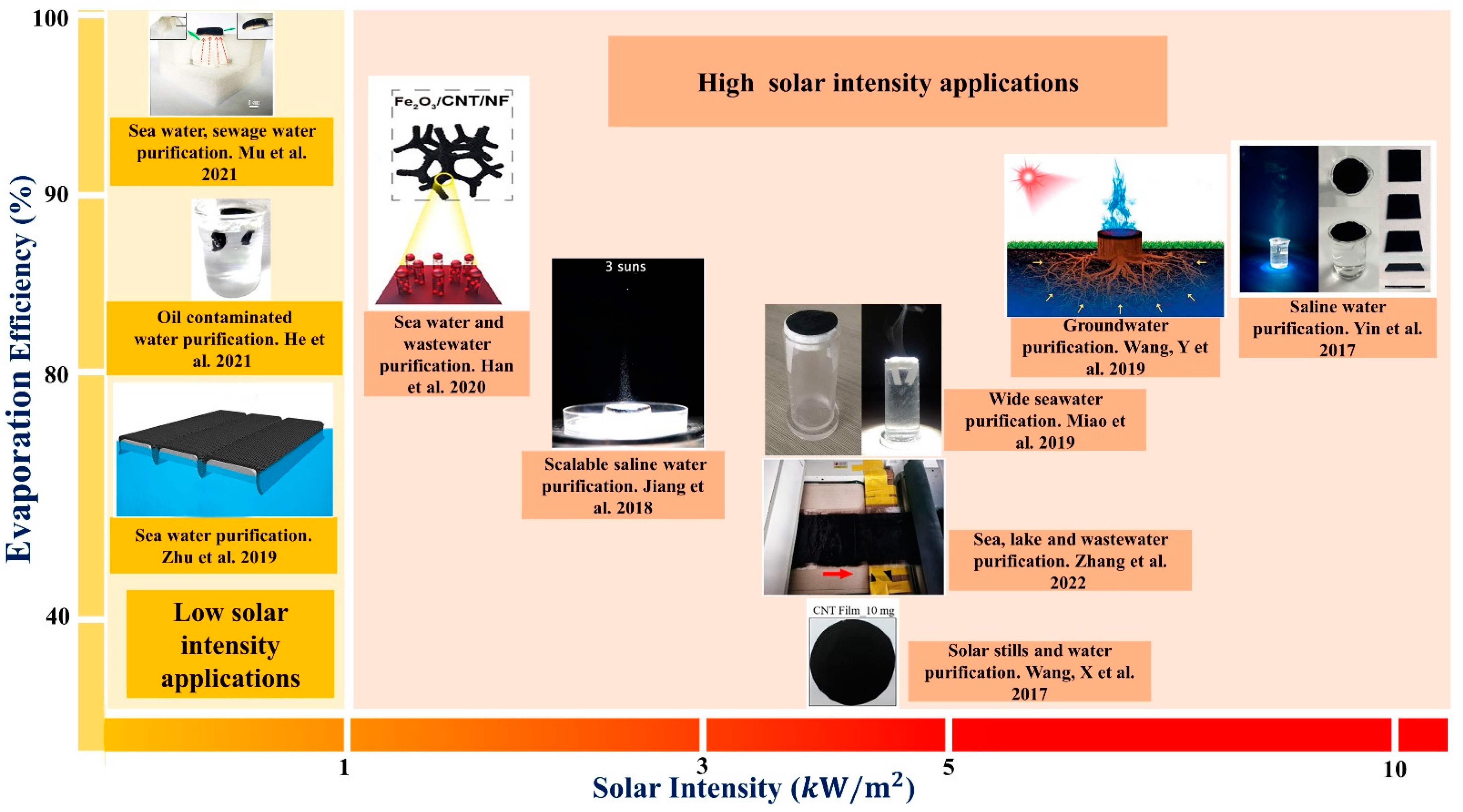
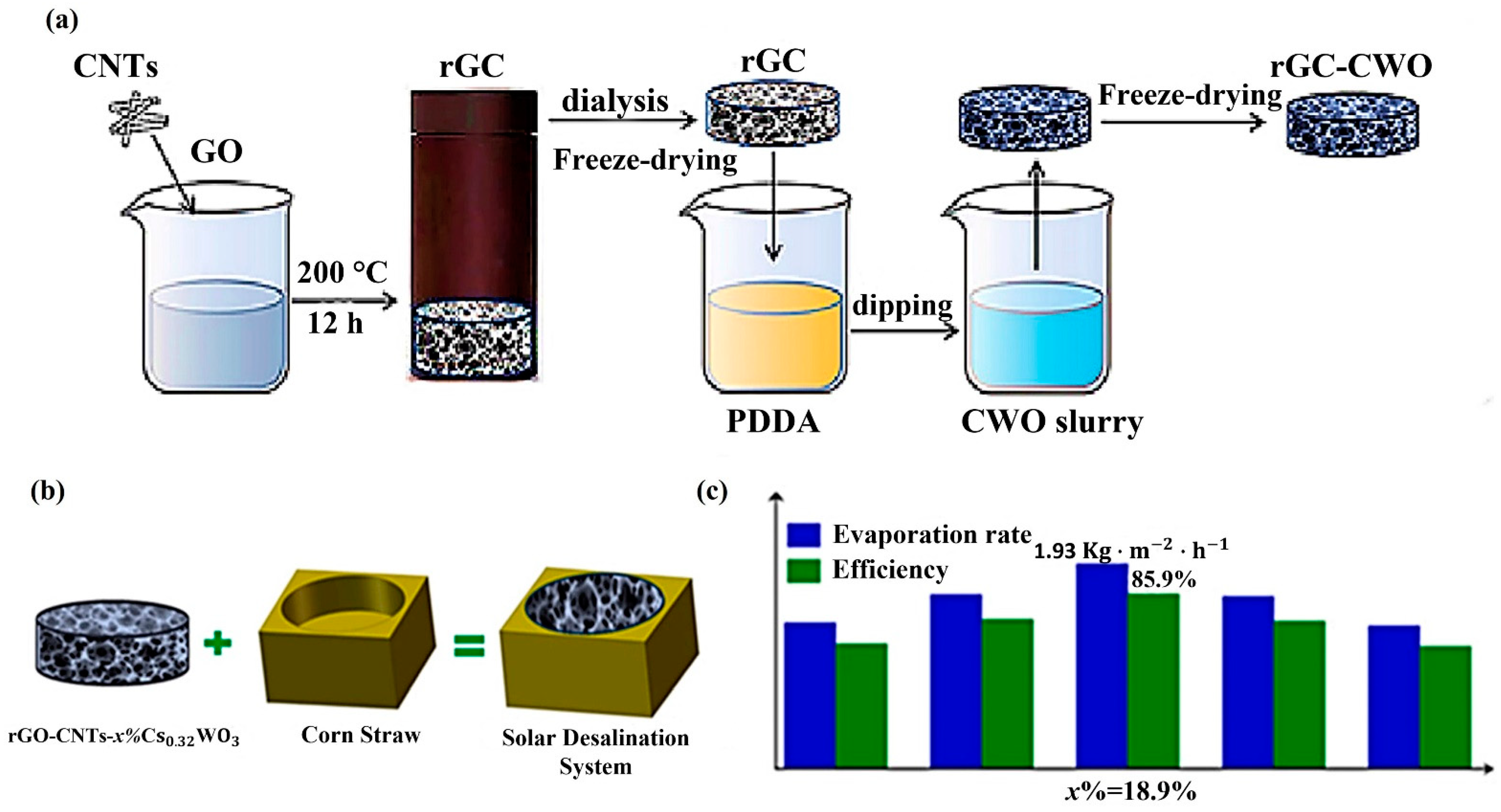
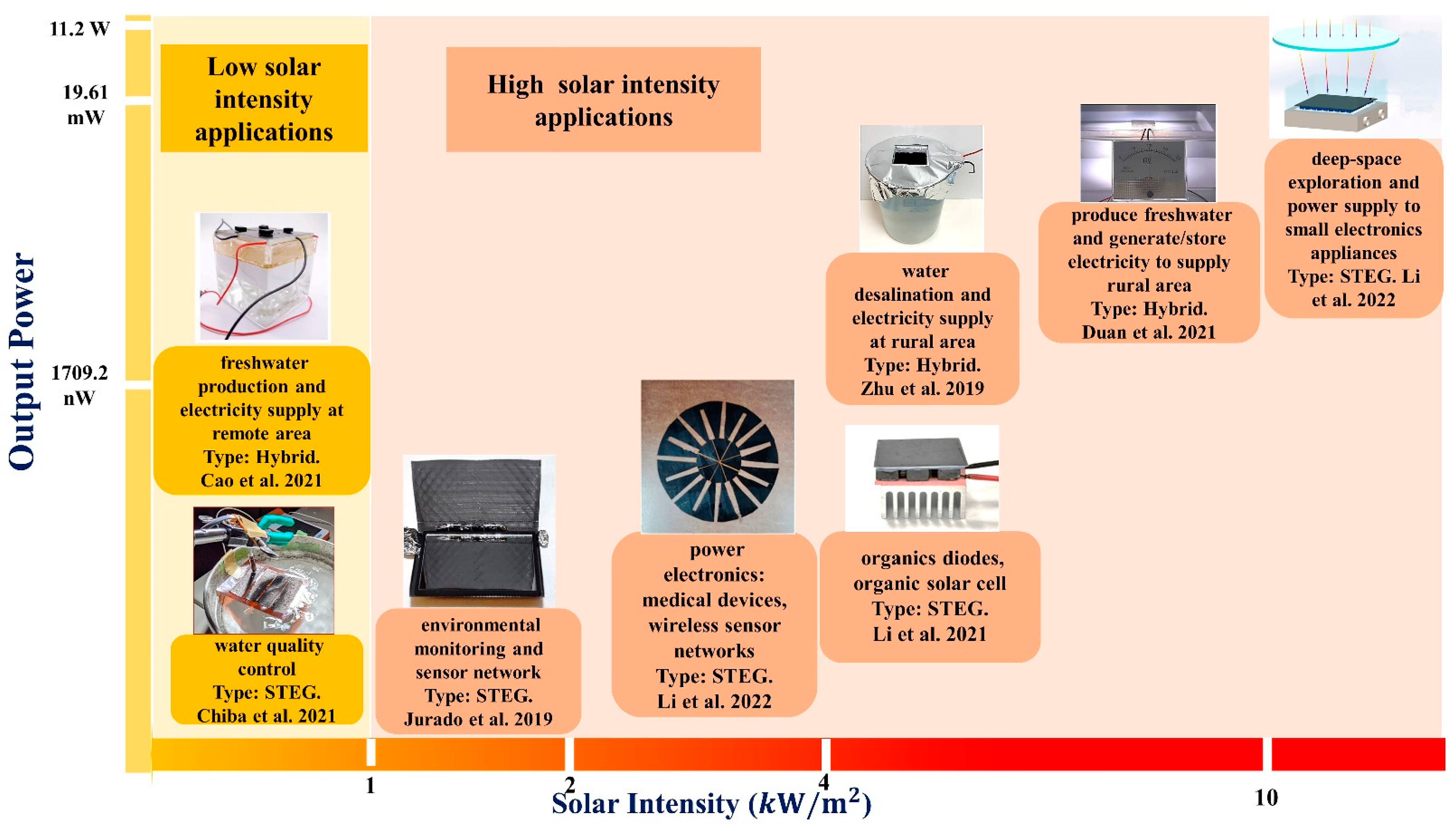
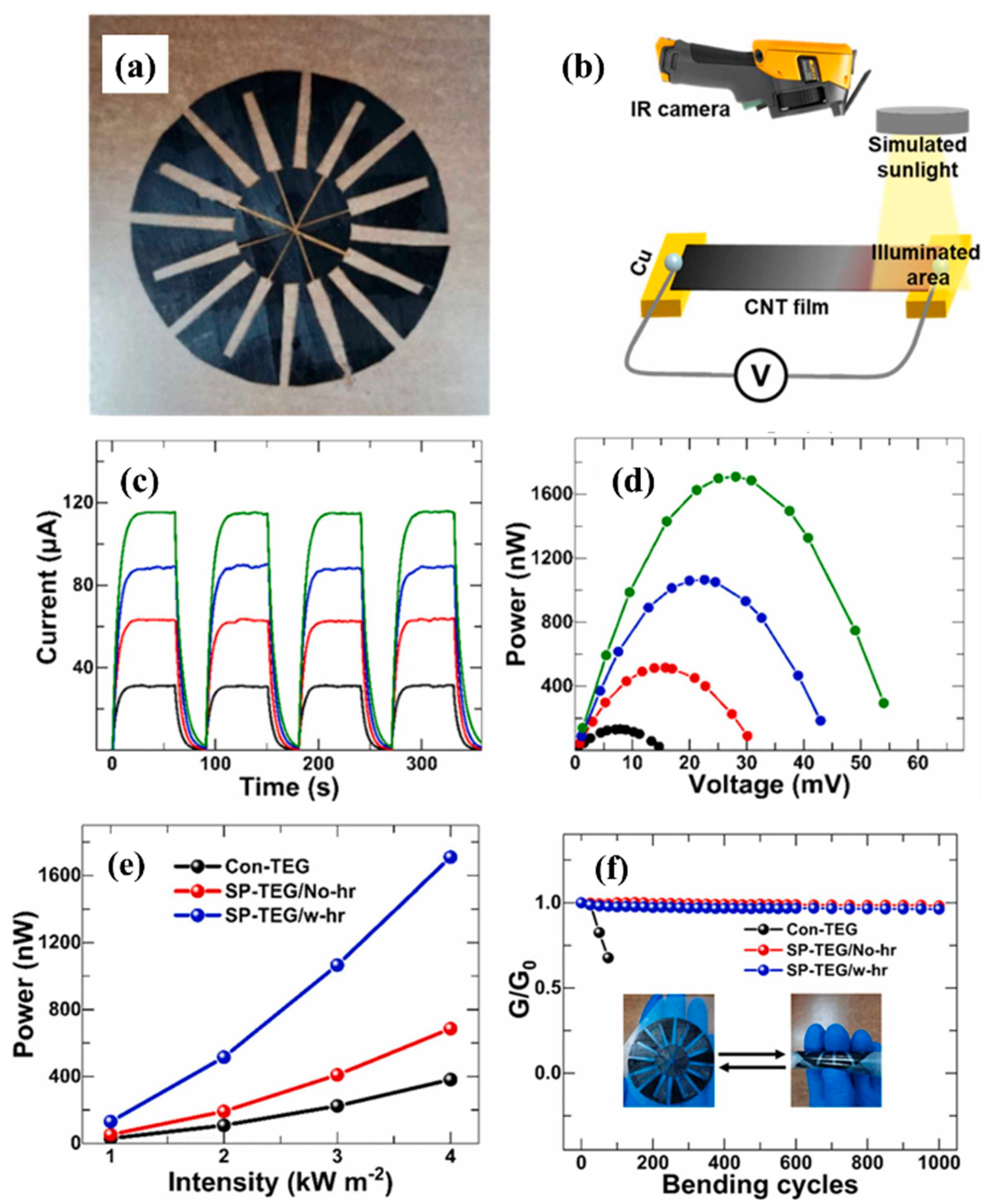
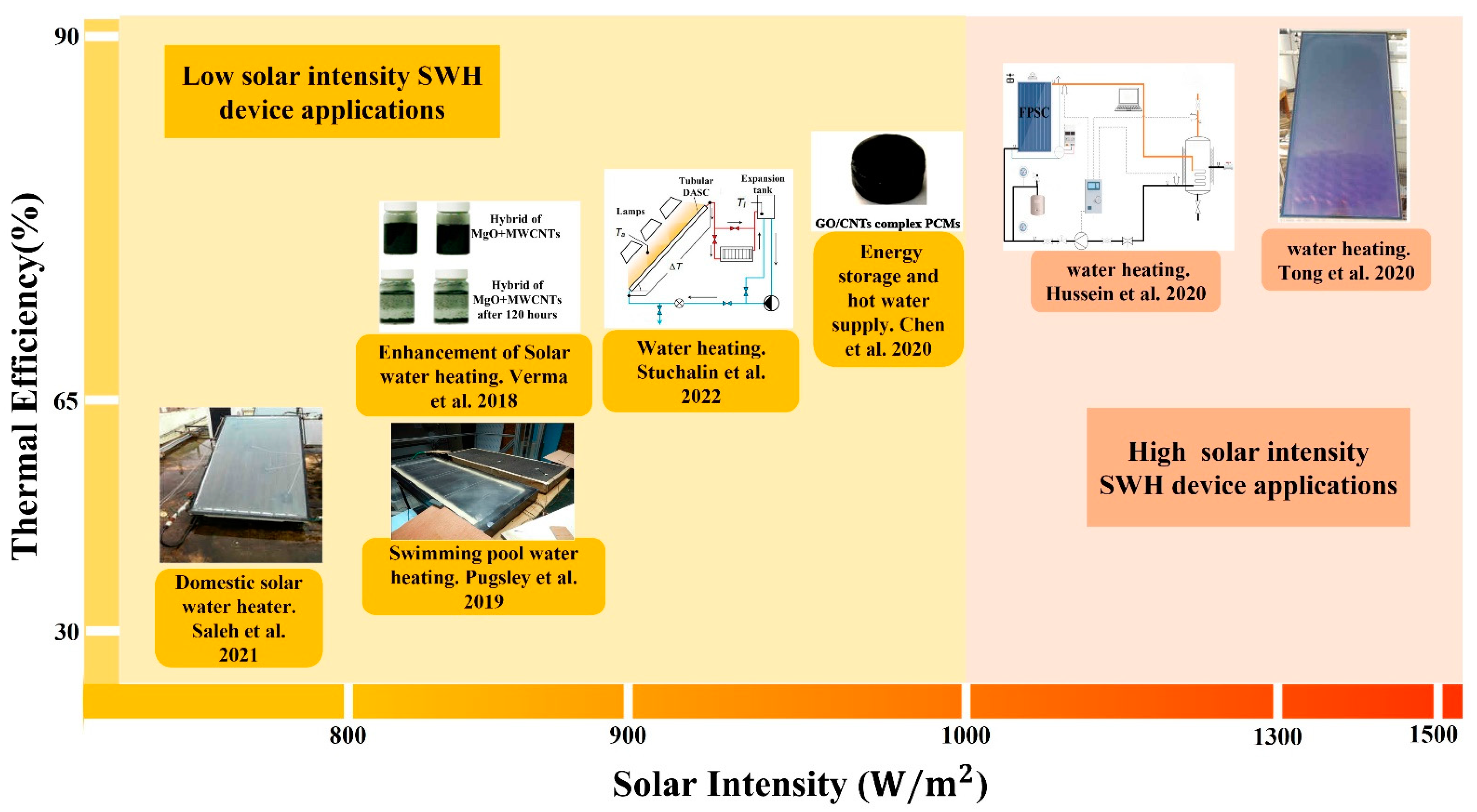
Publisher’s Note: MDPI stays neutral with regard to jurisdictional claims in published maps and institutional affiliations. |
© 2022 by the authors. Licensee MDPI, Basel, Switzerland. This article is an open access article distributed under the terms and conditions of the Creative Commons Attribution (CC BY) license (https://creativecommons.org/licenses/by/4.0/).
Share and Cite
Islam, S.; Furuta, H. Recent Development of Carbon-Nanotube-Based Solar Heat Absorption Devices and Their Application. Nanomaterials 2022, 12, 3871. https://doi.org/10.3390/nano12213871
Islam S, Furuta H. Recent Development of Carbon-Nanotube-Based Solar Heat Absorption Devices and Their Application. Nanomaterials. 2022; 12(21):3871. https://doi.org/10.3390/nano12213871
Chicago/Turabian StyleIslam, Saiful, and Hiroshi Furuta. 2022. "Recent Development of Carbon-Nanotube-Based Solar Heat Absorption Devices and Their Application" Nanomaterials 12, no. 21: 3871. https://doi.org/10.3390/nano12213871
APA StyleIslam, S., & Furuta, H. (2022). Recent Development of Carbon-Nanotube-Based Solar Heat Absorption Devices and Their Application. Nanomaterials, 12(21), 3871. https://doi.org/10.3390/nano12213871






